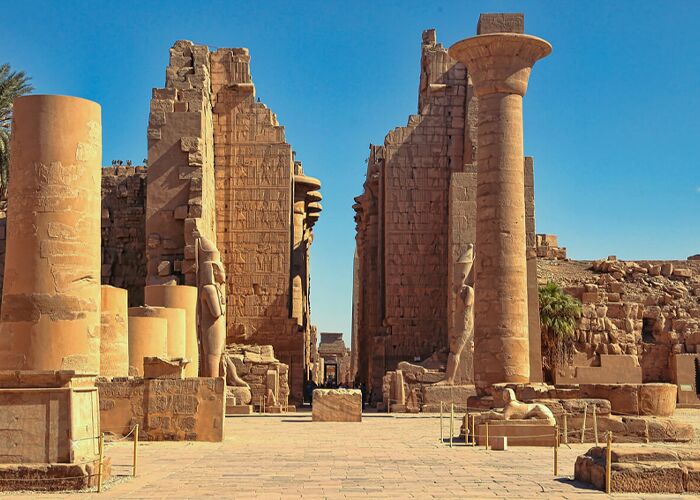Luxor is home to the Karnak Temple, Egypt’s most famous landmark.
Among the topics covered:
The Karnak Temple’s location
The Karnak Temple’s history
Attractions in the Karnak Temple
In Luxor, Upper Egypt’s Karnak Temple is a must-see for every Egyptophile.
Luxor Temple, on the other hand, is generally considered to be a better-preserved and more original building.
However, each temple has a different history. Karnak is a little town on the East Bank, across the Corniche from this temple.
Within a few minutes walking distance of Luxor Temple and Luxor city center.
Luxor may be reached through a number of forms of transportation, including trains that link Cairo and Aswan, including flights from Cairo, Hurghada, and Aswan. Luxor can also be reached via road from Hurghada and Aswan.
History:
One of Karnak Temple’s primary functions is to act as an important intellectual hub.
Over 400 square kilometers (900 square miles) of land is taken up by the complex, which includes temples, shrines and pylons, as well as many obelisks and other edifices.
All of Egypt’s most important rulers made significant changes to the complex to show their devotion to the deity Amun.
Karnak became one of the largest and most spectacular temple complexes in antiquity as a consequence of its development.
The most accessible portion of Karnak’s Precinct of Amun, which seems to be an unending sequence of giant pylons (Temple doors), massive statues, and great hypostyle walls, is the most popular with tourists.
The precinct of the temple of Amun is accessible by the “Processional Way of Ram-headed Sphinxes” (Amun was often depicted as having ram horns), which links the temple of Luxor.
First Pylon, Egypt’s tallest and broadest building, stands at 43 meters (141 feet) high and 130 meters (426 feet) wide, even though it was never finished.
The impressive Temple of Ramses III (20th Dynasty) and Seti II’s Temple (20th Dynasty), which housed the sacred boats of the triad, can both be seen in the complex’s courtyard.
Some of the most remarkable characteristics of the Karnak Temple
A 5,500 square meter “amazing forest” of 140 towering papyrus pillars was built beneath the Second Pylon in the 13th century BC by Seti I and his son Ramses II (59,200sq ft).
It’s a lot more sophisticated and extensive than just the Hypostyle Hall, built in 18th Dynasty Egypt and devoted to the deity Amon (1550-1295 BC).
Immediately beyond the Third and Fourth Pylons, in the courtyards of Queen Hatshepsut and Tuthmosis II, there are obelisks honoring both of Egypt’s female pharaohs (1473-58 BC). You may see the tip of her obelisk, which has fallen to the ground, as you approach the Sacred Lake.
In front of the Sixth Pylon, Philip Arrhidaeus, Alexander the Great’s half-brother, built the granite Amun Sanctuary.
A visit to the lotus and papyrus pillars, which depict Upper and Lower Egypt, and the granite Sixth Pylon is a must-do.
As shown by the images on the walls, this was the place where Amun’s effigy was kept and where presents were offered in his honor daily.
Outside the palace, there is a large Central Court and the Jubilee Temple of Tuthmosis, where the king’s life and authority were symbolically renewed during the jubilee.
That this enormous temple complex was only available to the strongest priests is a fascinating tidbit to remember.
Ordinary Egyptians couldn’t access the temple and had to depend on shrines built for intermediary deities around the wall’s circumference.
One such monument is the Chapels of the Hearing Ear, a grouping of chapels behind the Jubilee Temple.
the Sacred Lake shoreline, the temple may be found between the Third and Fourth Pylons.
Around 17,000 metal sculptures and 800 stone statues were found by the lake in 1903 in Cachette Court. The Egyptian Museum in Cairo has the best of them on exhibit.
When you watch the Karnak Sound and Light Show, you can see the illuminated sacred lake in all its glory as it tells the narrative of the temple. Attendance is free.

